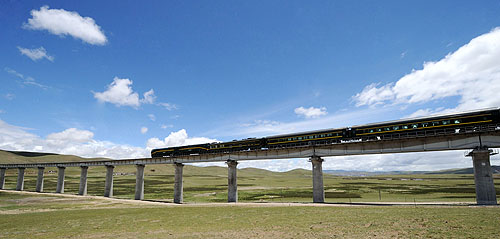|
 |
|
MONEY TRAIN: A train running on the Qinghai-Tibet Railway. The link, operating for three years, has brought considerable development to Tibet's economy (JUE GUO) |
The Qinghai-Tibet Railway, the 1,956-km transportation link that began operations over the "roof of the world" in 2006, made it through severe tests to its third anniversary on July 1.
The link is the world's longest plateau railroad, which goes from Qinghai's provincial capital of Xining to Lhasa, Tibet. It was the first railway to connect central Tibet to the outside world, running through the Qinghai Lake, Kunlun Mountain, Hoh Xil and the northern Tibetan grasslands. Qinghai's Golmud to Lhasa section zigzags 1,142 km across the Kunlun and Tanggula mountain ranges. About 550 km of the tracks run over frozen earth, the longest of all the world's plateau railways.
The railway is a highly symbolic part of China's western development strategy. Its completion and operation has changed the social and economic landscape of the autonomous region by greatly promoting the region's development.
Change of concept
With plenty of natural and cultural scenery, the region is also preparing to tap great business opportunities, including Tibetan medicine and processing farm and pasture products.
"Since the opening of the Qinghai-Tibet Railway, the thoughts of local herdsmen have appeared to gradually change," said Tinley Norbu, a Nagqu government official. More and more local herdsmen today have dropped their traditional living styles and started doing business.
Gega, a local Nagqu herdsman, often tried to start businesses but always failed. "The bad transportation conditions held me back," said Gega. But his yogurt business has begun to see considerable development. "The opening of the Qinghai-Tibet Railway makes my business much easier," he said.
He said 1 kg of yogurt used to sell for 15 yuan ($2.2) but has now climbed to 70 yuan ($10.25) per kg since the railway went into operation because more inland businessmen are coming to purchase the high-quality yogurt.
"I can earn more than 10,000 yuan ($1,464) each month from my business," said Gega.
Gega now makes contact with more local and visiting consumers. He has started to get business cards printed in both Mandarin and Tibetan.
"If foreign consumers come to buy my yogurt one day, I will also print English business cards," he said.
Economic boom
The Qinghai-Tibet Railway has played a crucial role in stimulating the economic development of Tibet and become an important channel for passenger and cargo flow to move between inland cities.
Statistics provided by the Beijing-based China Tibetology Research Center (CTRC) show that the Qinghai-Tibet Railway had carried almost 14 million passengers and 63 million tons of cargo by the end of May.
Tibet Glacier Mineral Water Co. Ltd. is an enterprise located in Lhasa's Damxung County. It is planning to expand production and has started to construct new infrastructure.
| 